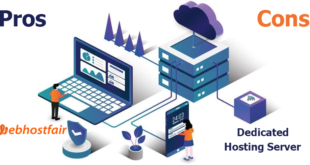A comprehensive guide to free domain name and hosting
Creating a website is an essential step for individuals, businesses, and organizations aiming to establish an online presence. However, the cost of domain names and hosting services can be a barrier, especially for those just starting out. Fortunately, there are options available that offer free domain names and hosting. In this comprehensive guide, we’ll explore how to get a free domain name and hosting, the benefits and limitations of these services, and some of the best providers in this space.
Understanding Free Domain Name and Hosting
What is a Domain Name?
A domain name is the web address where users can access your website, such as www.yourwebsite.com. It’s a crucial part of your online identity and should be easy to remember and relevant to your content or business.
What is Web Hosting?
Web hosting is a service that allows your website to be accessible on the internet. Hosting providers offer space on their servers where your website files are stored and managed, making them available for visitors to view online.
Free Domain Names and Hosting: An Overview
Free domain names and hosting services are offered by various companies to help individuals and small businesses get started without initial costs. These services can be particularly useful for personal projects, blogs, small businesses, or anyone wanting to test the waters before investing in premium services.
Benefits of Free Domain Name and Hosting
1. Cost Savings
The most obvious benefit is cost savings. Free services eliminate the need for upfront financial investment, making it accessible for everyone to create a website.
2. Ease of Use
Many free hosting providers offer easy-to-use website builders, templates, and management tools, which simplify the process of setting up and maintaining a website.
3. Great for Beginners
For those new to website creation, free hosting services provide a risk-free way to learn and experiment without financial commitment. This can be a valuable learning experience before moving on to more complex and paid options.
4. No Long-term Commitment
Free hosting services typically don’t require long-term contracts, giving you the flexibility to upgrade, change providers, or stop using the service at any time without penalties.
Limitations of Free Domain Name and Hosting
1. Limited Features and Resources
Free hosting services often come with limited storage, bandwidth, and other resources. This can be restrictive for websites with high traffic or large amounts of content.
2. Subdomains Instead of Custom Domains
Many free hosting providers offer subdomains (e.g., yourwebsite.provider.com) instead of custom domain names (e.g., www.yourwebsite.com). This can look less professional and be harder for users to remember.
3. Advertisements
To monetize their free services, providers may place ads on your website. This can detract from the user experience and reduce your control over your site’s appearance.
4. Limited Support
Free services often come with limited customer support, which can be a challenge if you encounter technical issues or need assistance.
How to Get a Free Domain Name and Hosting
Step 1: Choose a Provider
Several providers offer free domain names and hosting services. Research and compare the options to find the one that best suits your needs. Some popular options include:
- WordPress.com: Offers free hosting with a subdomain (e.g., yoursite.wordpress.com) and access to basic WordPress features.
- Wix: Provides free hosting with a Wix-branded subdomain and access to an intuitive website builder.
- Weebly: Offers free hosting with a Weebly subdomain and a drag-and-drop website builder.
- InfinityFree: Provides free hosting with no ads and support for custom domains if you have one.
- 000webhost: Offers free hosting with a 000webhost subdomain and basic site-building tools.
Step 2: Sign Up
Once you’ve chosen a provider, sign up for an account. This typically involves providing your email address and creating a password.
Step 3: Choose a Domain Name
Select your desired domain name. If the provider only offers subdomains, choose a name that reflects your brand or content. If the provider supports custom domains, you may need to register your domain separately.
Step 4: Set Up Your Website
Use the provider’s website builder or content management system to set up your website. Customize the design, add content, and configure settings to match your needs.
Step 5: Publish Your Website
Once you’re satisfied with your website, publish it. Your site will now be live and accessible to visitors via your chosen domain name.
Best Providers of Free Domain Name and Hosting
1. WordPress.com
WordPress.com is a popular choice for bloggers and small websites. It offers a free subdomain, basic design customization, and access to a wide range of WordPress features. The free plan includes 3GB of storage, but ads will be displayed on your site.
2. Wix
Wix is known for its user-friendly drag-and-drop website builder. It offers a free subdomain, a variety of templates, and 500MB of storage and bandwidth. Ads are displayed on free sites, but it’s a good option for visually appealing websites.
3. Weebly
Weebly provides a straightforward website builder with a free subdomain, 500MB of storage, and Weebly-branded ads. It’s suitable for small businesses and personal websites.
4. InfinityFree
InfinityFree offers free hosting with no ads, unlimited storage, and bandwidth. It supports custom domains, making it a great choice if you already have a domain name. However, it lacks a website builder, so you’ll need some technical knowledge to set up your site.
5. 000webhost
000webhost offers free hosting with a 000webhost subdomain, 300MB of storage, and 3GB of bandwidth per month. It includes basic website-building tools and displays minimal ads.
Tips for Maximizing Free Hosting Services
1. Optimize Your Content
To stay within the resource limits, optimize your website’s content. Compress images, use efficient coding practices, and limit the use of large files.
2. Monitor Usage
Keep an eye on your resource usage to avoid hitting limits. Most providers offer dashboards or tools to help you monitor storage, bandwidth, and other metrics.
3. Backup Regularly
Free hosting services may not offer comprehensive backup solutions. Regularly back up your website’s content to avoid data loss.
4. Upgrade When Necessary
As your website grows, you may need more resources or features. Be prepared to upgrade to a paid plan when necessary to ensure your website continues to perform well.
5. Consider Professional Email
Free hosting plans typically don’t include professional email addresses (e.g., [email protected]). Consider using a separate email hosting service for a more professional appearance.
Free domain name and hosting services provide an excellent opportunity for individuals and small businesses to establish an online presence without initial costs. While these services come with limitations, they can be a valuable stepping stone for those just starting out. By choosing the right provider and following best practices for optimization and management, you can create a functional and attractive website. As your needs grow, consider upgrading to a paid plan to access additional features and resources, ensuring the continued success of your online presence.
 webhostfair Web hosting news, reviews | Best web hosting service for your business
webhostfair Web hosting news, reviews | Best web hosting service for your business

